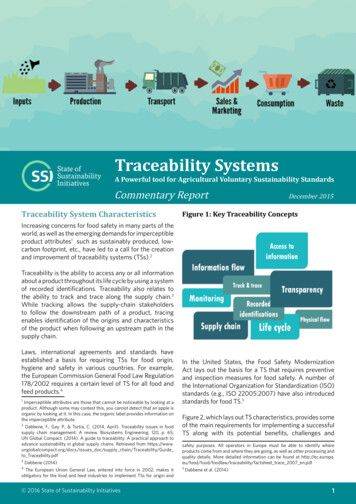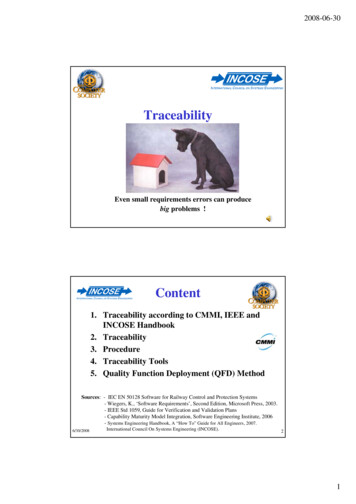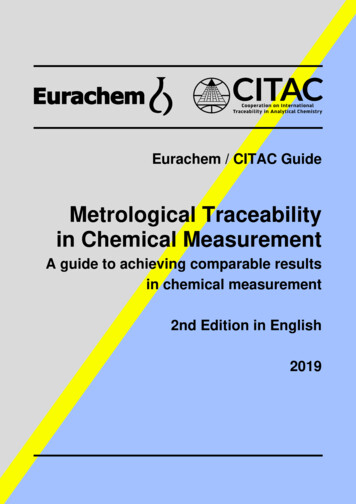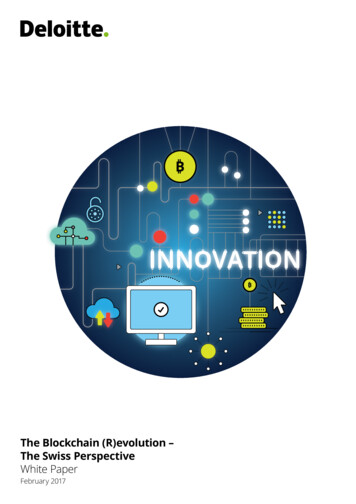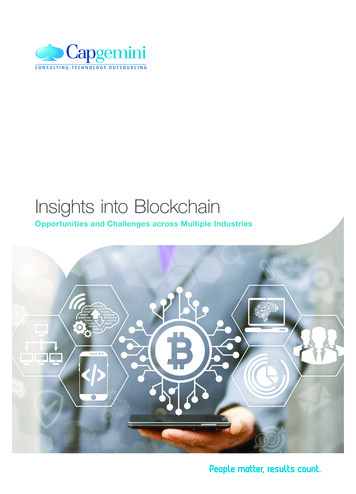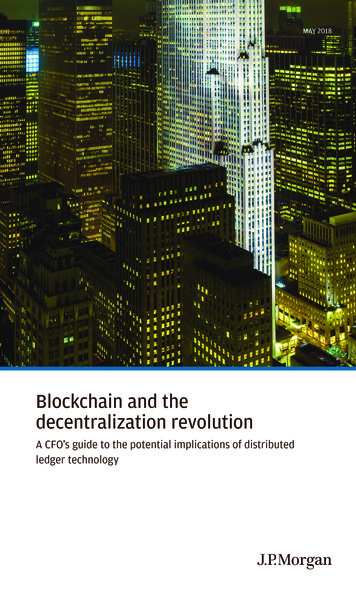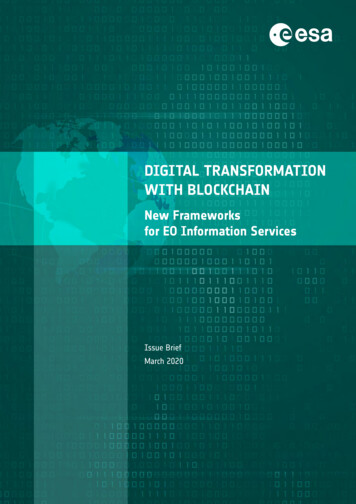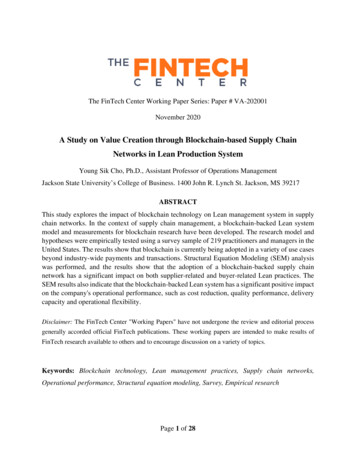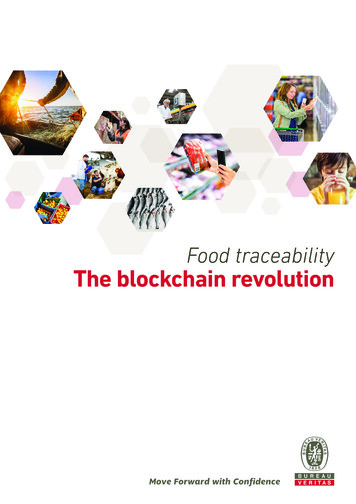
Transcription
Food traceabilityThe blockchain revolution
FoodtraceabilityHarnassing the power of blockchainto empower consumersImagine a future in which a shopper canwalk into a store, use their smartphoneto flash a code on a product, and see itscomplete history at a glance: where it comesfrom, how it’s been made, and how its safetyand quality have been ensured.Expected to do for transactions what theinternet did for information, blockchain cutsthe time and cost of verifying informationalong a supply chain. In doing so it increasesthe potential for absolute traceability, at acost acceptable to all players involved.Consumers already demand perfectfood transparency, available at the swipeof a finger. But costs and logistics havetraditionally made it an impossible goal.The purpose of this paper is to explainhow food traceability is revolutionizedby blockchain. We outline the traditionalobstacles in food traceability, before going onto explore how a blockchain-based solutioncould overcome them. Finally we delvedeeper into the key issues of governance andtrust and the likely future role for third partiessuch as Bureau Veritas in maximizing theintegrity of information.That is now changing with theadvent of a disruptive technology:blockchainFood traceabilityThe blockchainrevolution2
ContextTraceability issuesin the food supply chainMany brands have made strides in responding to consumerdemands for transparency, but complete traceability remainsan elusive goal. Why?There is a huge variety of dataA typical food supply chain involves 6-8stages: it can begin at the livestock feedstage, moving through farm, processing,manufacturing and distribution beforefinally reaching the retailer. A longsupply chain results in vast amounts ofinformation. Each stage includes numerousdata of interest to the consumer, fromchemicals used in feed and drugs usedduring the animal’s life, to the location ofthe farm, processing or manufacturingplant, ingredients used in processingand manufacturing, any certifications ofproducers or facilities . Sheer quantitymakes this data hard to capture, trackand verify.No single actor controls thesupply chainAlthough some members of the supplychain wield more power than others, nosingle actor controls the entire chain. Datais held in silos for fair commercial reasons,and no third party is fully legitimate tohold all the data. In addition, no party candictate how data should be collected– whilebar codes are used by large retailer andmanufacturing plants, for example, smallerplayers upstream are more likely to rely onpaper records.Food traceabilityThe blockchainrevolutionThere is no fail-safemechanism for detectingissuesInspections and testing are the standardmethod used to confirm food provenance,quantity and safety. But the volumesinvolved in the global food industry meanthat sampling can only ever verify theconformity of a small fraction of food sold.The seafood market in the US gives anidea of the problem: only 2% of seafoodentering the market is inspected.*Complete verification isextremely costlySampling, then, can never provide completetraceability. Yet the alternative – third partyinspections of all batches and processesat every stage – is prohibitively expensive.And even though consumers wanttraceability, few are willing to pay a largepremium for it.* data from the Food and Drug Administration (FDA)3
A disruptivesolutionIntroducing blockchainBlockchain is a shared, distributedledger that makes it possible to recordtransactions and track assets (for exampleproducts or money) without a centralrepository. Traditionally in business, allmembers of a network or supply chainkeep their own records, which may bechecked by a third party, for example anauditor. Blockchain enables all networkmembers to share a ledger, which isupdated through peer-to-peer replicationand validated by all parties every time atransaction occurs. In this way it improvesefficiency by eliminating duplication ofreconciliation efforts and reducing the needfor intermediaries.All of this makes blockchain ideal forend-to-end traceability, as it is designed totrack asset creation, transformation andtransactions.Party B’s recordsTransactions Digitally signed EncryptedParty C’s recordsParty A’s recordsA shared ledger is replicatedand permissioned by all partiesAuditor’s recordsFood traceabilityThe blockchainrevolution4
/ How blockchain can addressfood traceability issuesWhat if any of the parties could verify the conformity of any product batchat any stage, at a cost that was low enough to be absorbed by the supplychain while adding value to the final product?This scenario is possible with blockchain,which makes every party in the supplychain an observer of every transaction.In a food supply chain, for example, the foodprocessor or retailer would be able to seeand call out any anomalies upstream, andvice versa. For a transaction to be recordedin the blockchain, consensus is required:all supply chain members must agree onits validity. For example, if the quantity offish marked as coming from a sustainablefishing area sold by a fishing cooperativefalls short of the quantity entered into theblockchain by the processor, this mightsuggest the processor had mixed somecheaper, unsustainably sourced fish intothe batch. In this case, the next memberof the supply chain could refuse tovalidate the transaction. Once recorded, atransaction cannot be changed: it becomesimmutable. A failed test or inspection ona product at any stage of the supply chainwill be automatically traced to the origin ofthe failure, thus exposing wrong-doers andundermining their credibility.Food traceabilityThe blockchainrevolutionThree other features of blockchaintechnology make it highly suited to foodsupply chains:1. It is open to any participant and any1. t ype of information can be entered.2. It can use cryptography to protectcommercially sensitive information.Each participant has a unique ID and keypair (public/private), and security policiesgovern who sees what. In some cases(for example contract prices) only thetwo members involved in the transactionwill see the data.3. It may use smart contracts – a set ofautomated rules governing a transactiondesigned to provide extra security. In thecase of the fish supply chain, for example,these might specify that an auditor ora test be called every 100 transactionsbetween producer and processor.It is easy to see how the use of blockchain canincrease the reliability of information, makingcomplete traceability possible without any singleall-powerful actor, or the presence of anindependent third party at every transaction.5
Blockchain in practiceBlockchains requiresome level of governanceFor a blockchain for traceability to work,participants’ identity must be verified toguarantee their liability. This requires athird party or consortium to handle identityverification and management. Data entryprocess and interfaces need verificationto ensure they capture real-life situationscorrectly and fully. The blockchain alsoneeds to include appropriate checks, toensure that members cannot colludeoutside the blockchain to validatefraudulent transactions.Finally, the blockchain’s incentivizationmodel must be agreed. The low additionalcost of implementing a blockchain couldbe included in the consumer price with a small premium.This would be shared by members upstream the supplychain, thereby acting as an incentive. This incentivizationmechanism needs to be defined at the outset.Bureau Veritas, as a recognized independent thirdparty with expertise throughout the food supply chainis a natural choice to help put in place food traceabilityblockchain systems and devise appropriate systemsof governance.Third-party inspection bodies are also well placedto intervene at appropriate points and moments alongthe chain. This might include random product quantityor quality inspections, certification of managementsystems or inspections of facilities, for example.EXAMPLEFish supply chaintraceability recordsCold storageplaceShipmentRetailer check& SellDischarge& Transportin truckFishing vessel:Processingfinal product Canned tuna Frozen tuna Fishing set Transfert to differentwell onboard ObserverConsumercheckFishing vesselTruckCold storageProcessor Log-book / IMO Stowage diagramsheet Video (e-observer) S hipment receipt Tally sheet (weightcontrol) S izing & weightsheet C lient invoice S torage reciept Reception reciept Process sheet by step Final product control Client order & invoice Unloadinginspection C old storageinspection &audit Traceability audit /process inspection onsite record check Lab testing (DNA) onfinal productTransportcompanies Shipment /packing listRetailer Invoice &reception sheet/ storageTRADITIONALQUALITY ASSURANCEFOR TRACEABILITY Inspection duringfishing trip Records massbalance check Video check Final Randominspection (FRI) Pre-Shipmentinspection (PSI) FRI (quality,weight,traceability)BLOCKCHAINFood traceabilityThe blockchainrevolution6
Business nsortiumgovernance—Business rules—TechnologicalbackbonePRODUCTION01010101101 InformationTransaction feesSum at temporis etperdu sentrei rosae lessum in situ.Nam lieber at temporiset perdu lare sentreirosae sum in situ.Roseaat temporis etperdu lare sentrei rosaesum in situ.Rosae sine temporis etperdu lare sentrei rosaesum in situ.Tem am lieber at et lessur perdu lare sentreirosae sum in situ.Lieber at temporis etperdu lare sentrei rosaesum in lesae situ.Blockchain technology offersan unparalleled solution to food traceabilityIt gives consumersthe product transparencythey crave, via an efficientsystem that providesreliable information ata minimal cost.Food traceabilityThe blockchainrevolutionBlockchain’s veryadvantages – the needfor consensus, theimmutability of data,the ability to use smartcontracts and permissions– raise the stakes ongetting the system rightat the outset.Bureau Veritas is proudto be involved in someof the very first foodtraceability blockchainsand looks forward tohelping the industry moveforward thanks to thisexciting technology.7
We believe that Blockchain is a technology that is disruptingour traditional business and we need to leverage it to bringtraceability to a new era. We cannot continue inspecting just a smallpercentage of produce as it moves along the supply chain.— Vincent Bourdil, VP Food with Bureau VeritasGlobal Food Safety Conference, 2017For more information, please contactFood Service s.comABOUT BUREAU VERITASBureau Veritas is a world leader in testing,inspection and certification. We help clientsacross all industries address challengesin quality, health & safety, environmentalprotection, enterprise risk and socialresponsibility. We support them in increasingperformance throughout the life of theirassets and products and via continuousimprovement in their processes andmanagement systems. Our teams worldwideare driven by a strong purpose: to preservepeople, assets and the environment byidentifying, preventing, managing andBUREAU VERITAS SERVICESLe Triangle de l’Arche, 8 cours du Triangle, CS 90096, 92937 Paris La Défense Cedex, FRANCETel.: 33 (0)1 55 24 70 00 - Fax : 33 (0)1 55 24 70 01 - www.bureauveritas.comEditorial, design and production: IMPACT-communications.fr / BOLDcie.comPhoto credits: iStock / Thinkstock - 2017 Bureau Veritas. All rights reserved.reducing risks.
The blockchain revolution It gives consumers the product transparency they crave, via an efficient system that provides reliable information at a minimal cost. Blockchain’s very advantages – the need for cons


